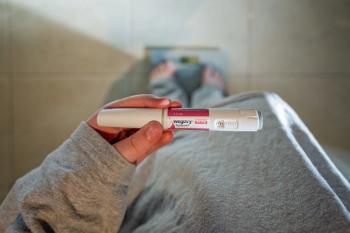
- August 2011 Oncology
- Volume 77
- Issue 8
Cancer Detection and Chemotherapy Complications
Mary Barna Bridgeman, PharmD Rupal Patel Mansukhani, PharmD
Case 1—Fecal Occult Blood Testing
LV is a 55-year-old man who would like to speak to the pharmacist about a home test kit for colon cancer. He recently read about the availability of a home test product to detect blood in the stool, and would like to use a test like this before undergoing a more invasive colonoscopy procedure. He denies having a family history of colon cancer or hemorrhoids and is not experiencing dark stools at this time. He reports he is in good health and takes no medications. What counseling points can you recommend to LV to ensure proper selection and use of a home fecal occult blood test (FOBT)?
Answer
Colon cancer is one of the most common types of cancers and a leading cause of cancer-related death in the United States. Routine screening is recommended for all individuals starting at 50 years of age (and for younger individuals with risk factors) and is the best means of preventing this serious but often treatable type of cancer. Technologies including high-sensitivity FOBT, flexible sigmoidoscopy, and colonoscopy may be employed to screen for cancer risk.
Home FOBT products may be used as adjuncts to more invasive procedures to help detect colon cancer and other causes of gastrointestinal bleeding, including hemorrhoids, anal fissures, colon polyps, and ulcers.1 There are several different types of products currently available for OTC use, including toilet tests (EZ-Detect Stool Blood Test), stool wipes (LifeGuard), and devices that require the user to manually collect stool samples (ColonCARE).
These noninvasive products all utilize a colorimetric assay to detect human hemoglobin. A color change indicates the presence of hemoglobin, but does not identify the source of blood, so not all of these products are specific for the detection of colon cancer. The toilet tests are placed into the toilet after the user has a bowel movement. A blue-green color change indicates a positive result, meaning that hemoglobin is detected in the surface water of the toilet bowl. Stool wipes are utilized to clean the anus after a bowel movement, and testing reagent is applied directly to the collection pad. Manual stool application devices rely on the patient to collect stool using a wooden stick, inserting the stick into a reagent bottle then applying solution to a test cassette and interpreting the results.
These tests are subject to interferences, including hemorrhoidal or menstrual bleeding; consumption of dietary red meat; use of nonprescription medications, such as aspirin, nonsteroidal anti-inflammatory drugs, and vitamin C; and use of toilet bowl deodorizers (for the toilet tests), among others.1 Product selection should be based upon patient preference; instruct LV to follow the instructions for the product he chooses. Remind LV of the importance of discussing his colon cancer risk factors, screening tests, and home test results with his physician.
Case 2—Chemotherapy-Induced Diarrhea
BJ is a 62-year-old man who presents to the pharmacy counter looking for instruction on the use of loperamide for the treatment of diarrhea. He has been diagnosed with metastatic colon cancer and has just begun treatment with irinotecan. Twenty-four hours after his first chemotherapy treatment, BJ experienced 5 loose stools. He is not experiencing abdominal pain, nausea, vomiting, anorexia, or fever. He was instructed by his oncologist to pick up some OTC loperamide for diarrhea relief. He asks you to describe the usual side effects and directions for loperamide when used for diarrhea associated with cancer treatment.
Answer
Patients experiencing diarrhea who are at risk of serious complications (ie, patients who have diabetes or cardiovascular or kidney disease, suffer from multiple medical conditions, or who are immunosuppressed) are usually not considered eligible for self-treatment for their condition.2 Despite the fact that BJ can be considered immunosuppressed due to his cancer and current chemotherapy, he has been instructed by an oncologist to pick up an OTC antidiarrheal to alleviate his mild symptoms at this time. Loperamide is considered a first-line recommendation for the treatment of mild or uncomplicated diarrhea associated with chemotherapy and is usually administered as a 4 mg initial dose after the first loose stool, then 2 mg every 2 to 4 hours until 12 hours have passed without a bowel movement.3 Side effects of loperamide can be attributed to its opioid agonist effects and can include dizziness and sedation, especially at the high doses used to treat this condition.
If BJ develops symptoms of dehydration, fever, abdominal pain, cramping, or if his symptoms worsen or persist for 48 hours or longer despite loperamide treatment, instructing him to contact his oncologist is prudent to prevent serious complications of volume depletion.3
Dr. Bridgeman is an internal medicine clinical pharmacist in Trenton, New Jersey, and clinical assistant professor, Ernest Mario School of Pharmacy, Rutgers University. Dr. Mansukhani is a clinical pharmacist in South Plainfield, New Jersey, and clinical assistant professor, Ernest Mario School of Pharmacy, Rutgers University.
References
- Briggs GC, Hurley H. Home testing and monitoring devices. In: Berardi R, Ferreri S, Hume A, et al, eds. Handbook of Nonprescription Drugs. Washington DC: American Pharmacists Association; 2009:917-946.
- WalkerPC. Diarrhea. In: Berardi R, Ferreri S, Hume A, et al, eds. Handbook of Nonprescription Drugs. Washington DC: American Pharmacists Association; 2009:289-308.
- Benson AL, Ajani JA, Catalano RB, et al. Recommended guidelines for the treatment of cancer treatment-induced diarrhea. J Clin Onc. 2004;22:2918-2926.
Articles in this issue
about 14 years ago
Rheumatoid Arthritis Watchabout 14 years ago
A Double-Edged Swordabout 14 years ago
The Pharmacy Benefit vs the Medical Benefitabout 14 years ago
Hepatitis C Case Study at Prosperity Specialty Pharmacyabout 14 years ago
Building Your Specialty Warehouse: Focus on Data Acquisitionabout 14 years ago
Competitive Advantages of Accreditationabout 14 years ago
The Payer Dilemmaabout 14 years ago
Eight Mega Trends Shaping the Future of Specialty Pharmacyabout 14 years ago
Conference Calendar Upcoming Fall/Winter 2011-2012Newsletter
Stay informed on drug updates, treatment guidelines, and pharmacy practice trends—subscribe to Pharmacy Times for weekly clinical insights.


















































































































































































































